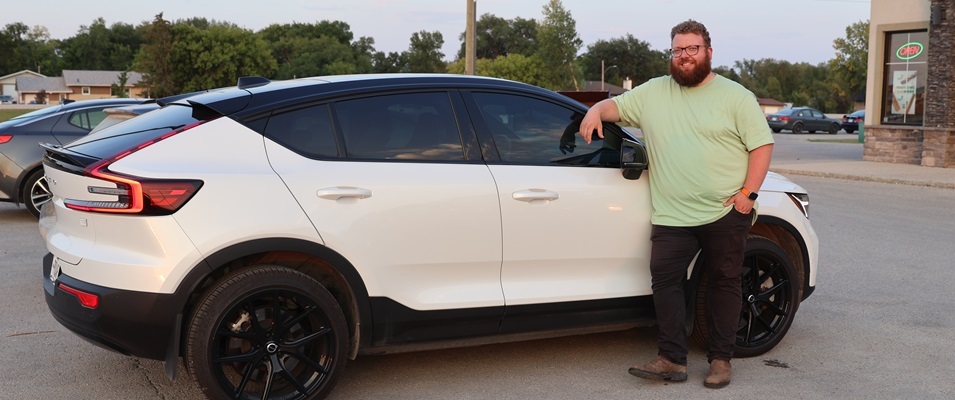
In the past decade, voices for environmental change have been decrying mankind’s addiction to fossil fuel use, citing its impact on greenhouse gas emissions. In response, governments have been introducing new zero-emission target strategies.
By 2035, the Canadian government says they anticipate a complete shift to zero emission technology in light-duty vehicles rolling off dealership lots.
On a federal scale, the message seems to be getting through. Since 2017, the number of battery-electric and plug-in hybrid vehicles on Canadian roads amounts to ten times what it did just seven years ago.
According to one resource, in the first quarter of this year Quebec saw the highest number of zero-emission vehicle (ZEV) registrations at just over 22,000. Ontario’s were half that at almost 11,000 and B.C. registrations totalled just under 10,000.1
In Manitoba, though, the transition to ZEVs has progressed at a much slower pace. Here, a mere one percent of new vehicles registered since 2017, or about 4,000, are zero-emission.
With recent changes to legislation, the governing NDP hope to alter that. Indeed, they are optimistic that ZEV uptake will triple by 2026.
This summer, Manitoba followed the lead of most other provinces by rolling out an incentive program to entice vehicle buyers to make the move to electric vehicles (EVs) or plug-in hybrids.
The $25 million in funding will provide individual buyers with a rebate of $4,000 on new vehicles and $2,500 on used. Some limitations apply.
The hope, as well, is that Manitobans will be motivated by the daily cost-savings attributed to EVs in comparison to gas-powered vehicles, especially in tough economic times like these.
And since Manitobans enjoy, on average, the second lowest energy costs across the entire country, thanks to local hydro-electricity production, it’s hard to fathom why the EV trend is slow to grow here.
In the end, some say it boils down to two primary concerns.
First, there is still a general lack of trust when it comes to new transitional technology.
One of the early pioneers in automobile technology, Henry Ford, is believed to have said, “If I had asked people what they wanted, they would have said faster horses.”
The second issue, and perhaps more weighty, is the lack of charging infrastructure available to support a large-scale move to EV use. Indeed, some say that incentivizing EV purchases without ensuring the widespread availability of charging infrastructure is like putting the cart before the horse.
Comparisons to Gas-Powered
In the world of EV technology, Tesla has long led the way. Founded at the turn of the twenty-first century, the company released its first fully electric vehicle in 2008.
Since then, Tesla has built an almost cult-like following in the world of EV owners.
Slowly, other automobile manufacturers have been perfecting their own EV models. Now buyers have a wide range of options produced by companies like Hyundai, BMW, Volkswagen, Toyota, Ford, and GMC.
According to Car and Driver, an online car guide, the EV presents some real pros which can’t be ignored.
The most obvious, of course, is the cleaner running engine which produces zero emissions while driving.
The net environmental benefit should be evaluated, though, based on how a province’s electric energy is derived. Where electric energy is produced through the burning of fossil fuels, the environmental benefits are reduced.
Another major win for the EV is the reduced maintenance it requires in comparison to gas- and diesel-powered engines. Oil changes become a thing of the past. And with all-around fewer moving parts, the electric motor simply has fewer components to break down.
Even the braking system tends to last much longer in an EV thanks to technology called regenerative braking.
Nothing seems to be lost, either, in terms of horsepower and torque, contrary to popular belief.
Car and Driver also notes three major cons with the EV, at least at this stage of development.
Without question, the EVs largest and most expensive component is a wearable item: the battery pack.
“According to the U.S. Department of Energy, the expected life of an EV’s battery pack is between 10 and 12 years,” the website says. “That said, battery packs can last longer than their estimate. Once a battery pack bites the dust, though, replacing it is rather pricey.”2
Replacement cost will vary depending on the type of EV and the manufacturer, but it’s safe to say that it will range in the thousands of dollars. Like any commodity, prices should come down in the coming years as demand increases.
Currently, companies are already working on refurbishing batteries which should help to save the consumer money.
Another con is the EV’s towing capacity in terms of pulling trailers and camping units. While the power is there, towing a significant amount of weight will reduce the battery’s range between charges by as much as two-thirds. This can be s a significant consideration for those who need to tow for any distance.
Of course, that problem could be compounded by a lack of charging stations en route to one’s destination.
Few online statistics, however, will be capable of providing a better overview of EV ownership than a firsthand testimonial. The Citizen reached out to local EV owners to find out more.
This article focuses specifically on EVs and not hybrid models.
The Downside of the EV
Gurjaspal Singh and his partner live in St. Adolphe. His wife purchased a Tesla Model 3 sedan in the spring of 2023 to save costs on her daily commute to Winnipeg. At the time, she paid just more than $60,000 for the vehicle.
Brand appeal is what made her decide on a Tesla, he says, and so far she’s not regretting her purchase.
Singh, on the other hand, says he’s not as impressed with the vehicle’s quality when considering its cost. It has some annoying squeaks, he says, and the seat comfort is not what you’d expect from a luxury vehicle.
“Driving down the highway, you have these seams in the road,” Singh says. “In the Tesla, you feel every seam. In the back seat you notice it even more.”
What’s even more annoying, Singh adds, are the driver control features on the Tesla dashboard.
Adjusting the wiper blade speed is just one example of what he says is a poorly planned design.
“You have to do it from the [dashboard touchscreen] without being distracted,” says Singh. “It’s like Tesla has decided that they want to give as little control to the user as possible. There’s a button on the steering wheel, but all that does is it opens up the option on the screen to change the wiper speed there.”
Île-des-Chênes resident Jordan Lépine test-drove a good many EVs before buying his Volvo C40. He, too, was unimpressed with the complexity of the Tesla’s driving functions when he took a model out for a spin.
It’s so different from a traditional vehicle, he says, that the dealership makes you watch an instructional video before you can drive your new Tesla off the lot.
“When you get into an electric Volvo, they look the same [as the gas-powered Volvo], and they’ve done that by design so as to no alienate you and make you feel like you’re driving a spaceship,” Lépine says. “Whereas Tesla has done the exact opposite. You get a Tesla and you have to learn to drive it.”
George and Roxanne Sawatzky moved to Niverville this spring from Vancouver. They’ve owned a Tesla since 2022.
Upon their arrival in Manitoba, the Sawatzkys quickly realized that their rear-wheel-drive model didn’t handle Manitoba winter driving very well.
“I don’t think we’d have bought an EV if we’d known we were coming to Manitoba,” says Roxanne.
But probably the biggest complaint the Sawatzkys have in regard to their EV is the fact that they rarely achieve the mileage per charge that the dealership told them they should.
“We were told a 460-kilometer range on a charge,” George says. “We took it to Arizona. We had to stop every two hours and charge for 35 to 40 minutes. We lost a whole day, plus we had to pay an extra night for a hotel. The charging was $20 per charge every two hours so it didn’t save us anything.”
On short trips around Manitoba, they say, they might get close to the advertised range. On a road trip, though, it drops down to around 260-kilometres.
Part of the problem, they add, is that the charge level is affected with the use of every single vehicle function. So using the heater or A/C, the wiper blades, the radio, all of these things reduce the charge range. Uncontrollable elements such as wind and hilly terrain also affects the charge range.
“Your car cues you and says, ‘You’re going to make it to this [charger],’ but there are so many variables, like what the wind is like,” Roxanne says. “Tesla may say you’ve still got 60 minutes left to go on your battery. But if it’s quite windy, you may have only 20 minutes.”
For this reason, they say, it’s quite imperative to stick to a predetermined route when travelling with an EV. There’s little room for spontaneous detours along a more scenic route if the scenic route isn’t equipped with plenty of charging stations.
On another occasion, a day trip to Grand Forks ended up costing the Sawatzkys a night in a hotel when they discovered that chargers around the city were down on the day they arrived.
Lépine agrees that this can be a problem. Tesla charging stations, he says, are known to be reliable. Non-Tesla chargers, on the other hand, are often problematic or altogether dysfunctional.
Lionel Head of Niverville has owned his 2024 Chevy Equinox EV for only two months, but he still feels it’s been one of the best moves he’s made in a long time.
He adds that EV ownership is not for everyone. It’s certainly not for those who live in apartment blocks or condominium complexes where personal charging systems aren’t an option. To charge at a public system is inconvenient and expensive.
But for Head, there are few drawbacks so far. If he ever had to have his vehicle towed, he says, he imagines a special tow truck would be required due to the additional weight of the vehicle. As well, servicing the vehicle will require a repair shop with hoists that can manage the extra weight.
Both Head and Lépine have had charge range experiences very different from that of the Sawatzkys.
The advertised range on Head’s Equinox is around 460 kilometers. From personal experience, he believes that he’s averaging more than that.
The computer on Lépine’s Volvo has undergone numerous software updates since he’s purchased it and, with each one, the vehicle has become more and more accurate in terms of judging charge rate based on driving conditions.
His most recent update actually made improvements to the range, something Lépine wouldn’t have believed possible if he hadn’t experienced it. It went from an average 380-kilometre range to 415 kilometres literally overnight.
Lépine put it to the test and rolled into his garage at the 415-kilometre mark.
The Upsides
When it comes to the local commute, these EV drivers all agree that the daily cost savings in fuel is hard not to get excited about.
“With Manitoba’s electricity prices, it’s very economical,” Singh says.
He adds that he noticed very little difference in his hydro utility bill since his EV charger was installed.
The Sawatzkys concur. A trip to Costco on the west side of Winnipeg costs them around $1.30 in electricity. Having a personal charger in their garage has saved them around 75 percent of what it would cost to charge at public charging stations.
For Lépine, saving money on fuel was the number one reason for his EV purchase.
“I used to have a comparable SUV and I do quite a lot of driving,” Lépine says. “I was spending almost $2,000 a month on fuel before. My cost to charge my EV now, on average, is $20 per month.”
Head is confident that he’s in for some major long-term savings too.
“There’s really not a lot to go wrong with an EV,” says Head. “An internal combustion engine is a much more complicated system than an electric one. You don’t even have to replace the brakes very often because of regenerative braking.
Regenerative braking, also known as one-pedal driving, is an energy recovery mechanism that slows the vehicle down when pressure is removed from the accelerator pedal. At the same time, this additional energy is recovered by the battery, essentially adding kilometres to its charge range.
“I could take you into the city, drive all over the city, take you back to Niverville and not have to touch the brakes once,” Head says. “That’s why you rarely have to replace your brake pads. Because you’re rarely using them.”
Even in terms of replacing the EV’s most expensive component, the battery pack, Lépine isn’t deterred. His vehicle came with an eight-year battery warranty at no additional cost. Of course, that doesn’t mean the battery will die in eight years.
“A lot of people say, ‘Good luck when the battery goes at 300,000 kilometres,’ Lépine says. “Show me a BMW, a Mercedes, or an Audi that has lived to 300,000 kilometres and hasn’t had some kind of major engine or transmission issue.”
As is true for any technology that becomes more commonplace, prices for new EVs have been trending very near that of their gas-powered counterparts these days. In just two years’ time, the Sawatzkys say that their $70,000 entry model Tesla now sells for under $50,000.
Charging Your EV
Head says there are three levels of charging systems for EVs and each one has the ability to charge an EV at different speeds.
For home use, EV owners can install a level one charger, which requires a simple 110-volt outlet. This is a very slow way to charge your battery.
The level two charger, on the other hand, requires 220-volt power and it’s what Head had installed in his garage.
“This speeds it up tremendously,” Head says. “It’s about ten times faster.”
Level three chargers provide the fastest charge. These can be found in some high-use public places and are commonly used at the Tesla supercharger stations.
The level of the charger usually determines the cost per use at public stations. Typically, charging can range in price from free to $20 per hour.
“The only two fast-charging options I have are in Morris or at Polo Park,” Singh says. “I could do slow charging, but it could take hours.”
The last time he did that, he says, it took 50 minutes of waiting to get to 45 percent charge. It was at this point that he recognized the importance of owning a personal home charger.
For Lépine, the longest wait he’s ever had at a public charger is 15 minutes, even on level two chargers.
Finding the various charging stations is also easy. Every EV comes equipped with computer systems that lay out all the charging stations along your route and the cost of charging at each one of them. They can also tell you whether certain chargers are available or in use.
Online apps, such as PlugShare, are also readily available to help you plan a stress-free road trip.
Manitoba’s Slow Uptake
Lépine theorizes that the slow uptake towards EVs is largely due to misinformation, some of which suggests that the environmental footprint to manufacture an EV battery outweighs the environmental benefit of driving one.
But, says Lépine, it statistically takes only three years of EV ownership, during which time you’re creating zero emissions, for the environmental cost to balance out. In year four and beyond, the real environmental benefits of EVs are realized.
“I don’t understand why someone wouldn’t want to move toward a better solution,” Lépine says.
As for the new provincial incentives, Lépine says the government could do a lot more to encourage EV purchases, such as issuing the grant funding at the time of the purchase rather than making buyers apply for the money and then wait for a refund.
Mixed Feelings
If they were to go back and do it again, the Sawatzkys say they’d buy a hybrid instead of an EV. For Manitoba driving, they believe it just makes better sense.
It was the hype and strong environmental messaging in Vancouver at the time that convinced them to spend the money on an EV in the first place.
“We don’t typically do stuff like that,” Roxanne says. “It was a huge amount of our savings.”
While they don’t discourage others from owning an EV, they strongly recommend that people rent one for a month first so they know exactly what they’re getting themselves into.
Lépine would do it again in a heartbeat and he’d repeat his decision to buy what looks like your average soccer mom vehicle.
“It’s just your average looking SUV until you realize it’s electric, until you realize it’s got 400 horsepower and 600 pounds of torque and does zero to sixty in under four seconds,” Lépine says. “Normally, to get those kinds of figures, you’re spending $90,000 for a performance vehicle that you can’t drive all year round.”




















